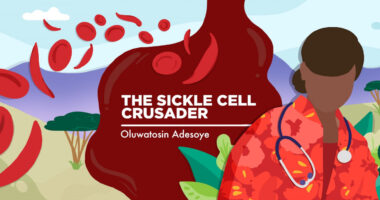Infections are a silent menace for many living with sickle cell disease
A childhood tuberculosis infection underscored my increased susceptibility

Pain and anemia seem to be the loud hallmarks of sickle cell disease. Because many patients and caregivers prioritize addressing the challenges posed by these issues, they tend to overlook infections. But despite their quieter nature, infections pose a grave threat and stand as the leading cause of death among people living with sickle cell disease.
Personal experience
Reflecting on childhood memories, I noted some recurring relationships between infections and my health. Whenever I left any upper respiratory tract or malaria infection untreated, it repeatedly triggered pain crises for me. This pattern persisted until I learned to promptly treat infections to avert impending crises. I also noticed how I’m usually more prone to infections than my peers, compelling me to prioritize infection prevention measures later on in life.
As a child, although I intermittently experienced sickle cell crises, I was able to lead a relatively normal life. My parents were able to keep my sickle cell diagnosis hidden from me for a while. However, this changed when I was around 11 years old, as I began experiencing debilitating symptoms such as constant fatigue, low-grade fever, and loss of appetite.
Initially, my parents treated me for malaria and anemia, but despite the treatment, my condition continued to worsen. I started experiencing more symptoms, including weight loss, enlarged lymph nodes, and paleness of skin. At this point, they were alarmed and took me to the hospital.
Because we lived in a town without a tertiary healthcare facility, the doctors I encountered insisted on a diagnosis of severe malaria infection; yet there was no improvement in my health status.
Concerned for my life, my family eventually took me to a tertiary healthcare center in another town. A consultant pediatrician with extensive expertise and experience correctly diagnosed me with pulmonary tuberculosis, even with the absence of definitive symptoms like cough, hemoptysis, and night sweats — a factor that had made the diagnosis difficult for previous doctors. Further investigations confirmed this diagnosis; I was done enduring months of uncertainty and numerous incorrect diagnoses.
The moment was a mix of relief and heartache, as my parents had to share two life-altering revelations with me in a single day. I was told that not only did I have sickle cell disease, but I had also somehow contracted a tuberculosis (TB) infection, which had to be explained in detail.
Despite the weight of the news, my parents offered reassurance that the TB infection was treatable and that I would ultimately recover. Though it was a sad day, I clung to a sense of inner strength and faith bolstered by my belief in God. I boldly faced the extensive treatment. The treatment regimen was supposed to take nine months; it eventually took one year, but I survived.
The question is, does this infection have anything to do with my sickle cell diagnosis? Yes, it does. Sickle cell disease weakened my immunity and made me susceptible to contracting tuberculosis. It also probably contributed to my extended period of treatment.
Sickle cell disease and infections
Sickle cell disease predisposes people to infections and can aggravate the severity of an infection by compromising the immune system. The spleen is a vital organ in the immune system, responsible for filtering blood, removing old or damaged cells, and producing antibodies. In sickle cell disease, the sickling of red blood cells can impair blood flow to the spleen, causing it to malfunction, ultimately resulting in its death (splenic infarction).
The spleen may undergo fibrosis, lose function, and shrink to the point of being undetectable, mostly in individuals with sickle cell anemia. This process is known as autosplenectomy. The loss of spleen function diminishes the body’s ability to combat infections, increasing patients’ susceptibility to microbial invaders.
In addition to splenic complications, deficiencies in micronutrients due to impaired blood circulation in sickle cell can further compromise immune function, exacerbating the risk of infections. Moreover, interventions commonly used in the management of sickle cell disease, such as frequent blood transfusions, can increase the likelihood of developing infections such as hepatitis, adding another layer of infectious vulnerability.
According to an article published in 2010 in the International Journal of Infectious Diseases, infections rank as the leading cause of mortality in sickle cell patients globally. After my life-threatening experience with tuberculosis, I have learned critical measures to prevent infections — a topic for my next column.
In conclusion, sickle cell patients must realize the negative impact of infections on their morbidity and mortality. Therefore, it’s imperative to prioritize infection prevention strategies and timely treatment of infections to improve quality of life and increase life expectancy of those with sickle cell disease.
Note: Sickle Cell Disease News is strictly a news and information website about the disease. It does not provide medical advice, diagnosis, or treatment. This content is not intended to be a substitute for professional medical advice, diagnosis, or treatment. Always seek the advice of your physician or other qualified health provider with any questions you may have regarding a medical condition. Never disregard professional medical advice or delay in seeking it because of something you have read on this website. The opinions expressed in this column are not those of Sickle Cell Disease News or its parent company, Bionews, and are intended to spark discussion about issues pertaining to sickle cell disease.








Jacqueline Medler
Thank you, Dr Adesoye for your personal experience and your doctor insight. Please continue to advocate for Sickle Cell patients. We need you and your hard work.
Much Love,
Jacqueline Medler